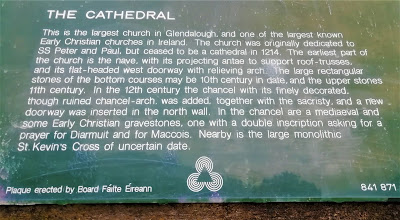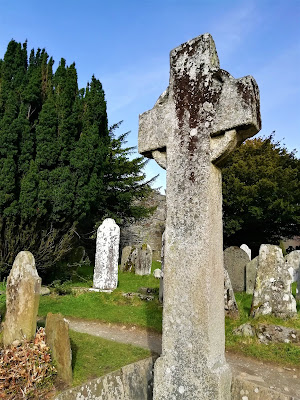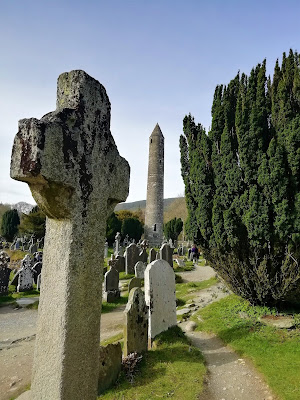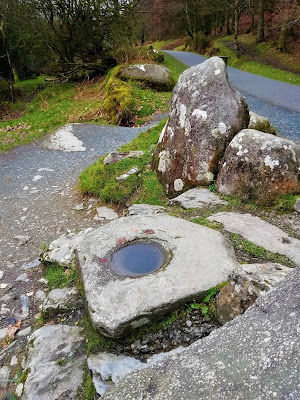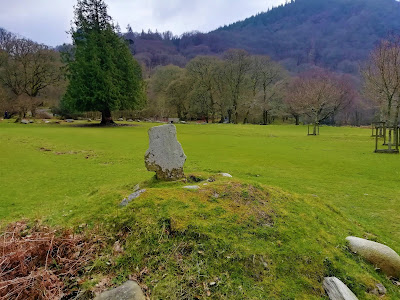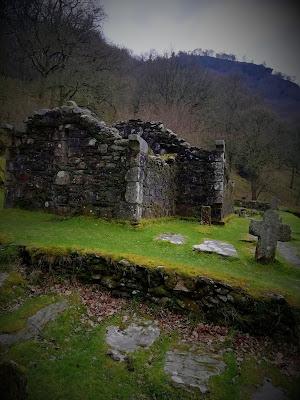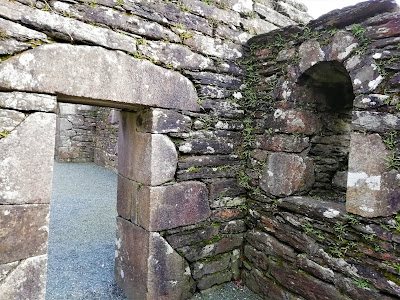Glendalough in Wicklow is the site of a huge Monastic settlement originally founded by Saint Kevin in the 6th Century. Glendalough means the valley of the two lakes.
Saint Kevin was reputed to have lived to the ripe old age of 120 years. He is associated with a love for nature and animals, particularly birds. He reputedly lived as a Hermit at Saint Kevins Bed, a cave beside Temple na Skellig,which is only accessible today by either scrambling or rock climbing so don't be tempted to try
to visit it.
to visit it.
I'll post pictures in chronological order as I toured the site. There is quite a lot to see at Glendalough and the visitor may well choose a different path but this was my loop of Glendalough.
The Photo's above are just a snapshot from inside the Visitor Centre. I started at the Visitor Centre but only I actually went inside on another day. From the Visitor Centre I made my way past the Hotel and on to the entrance proper,
"The Gateway."
"The Gateway."
The Gateway is the double arched Romanesque entrance to Glendalough Monastic Settlement. As far as I am aware it is the only surviving Romanesque gateway arch into a Monastic settlement in Ireland. It would originally have been a two story building with a roof and I presume a Gatekeeper at the entrance.
Immediately after entering The Gateway on the right hand side is the "Sanctuary Stone."
This large stone has a Cross inscribed on it and just looking at people entering it was apparent that most people hadn't even noticed it. It is said that if you managed to reach the Sanctuary Stone then your pursuers had to give up the chase and let you go, no matter what they were pursuing you for.
After entering I turned right and went towards the Round Tower. These incredible structures were built between the 9th and 12th Century and are uniquely Irish. About 85 complete or partial Round Towers remain in Ireland with 2 in Scotland and 1 in the Isle of Man, no doubt their design brought from Ireland as Christianity flowed back eastwards again from early Irish Monasteries to Britain and mainland Europe.
From the Round Tower I head to the Cathedral which is the largest of the Churches at Glendalough. It has some Romanesque remnants on its arch and interesting features inside. You will see it from the Round Tower close by.
Leaving the Cathedral and just outside its entrance is a High Cross. This is Saint Kevin's Cross which was carved from a single piece of Granite. It is said if you can wrap your arms around it and tip together the fingers from each hand you will get a wish granted. I have done this and a new car has still not arrived in my Driveway but I'll keep my fingers crossed.
Straight across from Saint Kevins Cross is "The Priests House." This small Romanesque style building may have been used as a communal sealed tomb. Its use is uncertain but it gets its name from the practice of burying Priests in it during the 18th and 19th Centuries.
Just outside The Priests House is a beautiful unmarked Cross possibly made of Schist which I found remarkable for its pure simplicity.
From here I head to Saint Kevin's Kitchen, so called because the mini Round Tower style bell tower on it might be mistaken for a chimney. This Church has a lovely Corbel type roof.
Beside Saint Kevin's Kitchen and sunken into the ground is a small Bullaun Stone.
Some Bullaun Stones may possibly be thousands of years old. They may originally have been designed for grinding things in such as grains and cereals. Their later uses were generally to hold water, most likely for ceremonial or religious use.
Also alongside Saint Kevin's Kitchen are the remains of Saint Kieran's Church. This is the smallest of the Churches at Glendalough and all that remains of it are the walls up to about knee height.
From Saint Kieran's Church I cross the river by footbridge and see a large Bullaun Stone, the Deer Stone. The Bullaun Stone here was possibly a station on a pilgrim trail.
Turning right at The Deer Stone I follow the trail towards a visitor information Centre beside the upper lake. Here I find The Caher, the remains of a circular enclosure. A Caher would originally have been a type of circular fortification and much larger than this enclosure.
Dotted around the Caher are small grassy mounds with various Crosses and it is thought that perhaps pilgrims walked from Cross to Cross while praying here.
Close by are the remains of a rectangular structure with a single Cross standing centrally on it. I have been unable to find out what this structure is.
Back onto the trail I follow the signage for Reefert Church and Saint Kevins Cell. Reefert Church is associated with the O'Tooles. Saint Laurence O'Toole was given Sanctuary in Glendalough ( a bit of argy bargy involving kidnap and the King of Leinster Dermot McMurrough) where he became a Monk and then the Abbot. He was appointed Archbishop of Dublin and died in France trying to act as a peace broker. His heart is in a reliquary at Christchurch Cathedral in Dublin, pictured below.
After Reefert Church I head straight on to the Site of Saint Kevin's Cell. This is fenced off and dangerous so keep behind the fence. I have an old photo from before there was fencing of a ledge which may have been where Saint Kevin's Cell possibly stood. His Cell I believe was a small Beehive Hut although I don't know if this is true.
Near here you will see a well designed small Sculpture of Saint Kevin with a Bird in his hand.
I then retrace my steps back to the Deer Stone and the footbridge across the river. If you want to visit Saint Saviour's Church (which I didn't have time to do) you simply go straight on for about a Kilometre instead of crossing back across the bridge.
Heading out of "The Gateway" I turn left straight away on the road and after 300 metres on my left I enter a field and use several stiles to cross the fences and visit Saint Mary's Church (I also passed a small modern Sculpture on my way). Not many people visit Saint Mary's Church but it's worth a visit. It has a lovely Altar with a Bullaun Stone built into it.
Leaving Saint Marys Church I head onto the road and back the way I came. I stay on the road and head straight past the Hotel and the Car park at the Visitor Centre and after a few hundred metres on the road I see the sign for Trinity Church on my Right.
There's a hidden wealth of treasures I've no doubt missed in Glendalough. There is also a good long walk to the site of the Miner's village above the lakes which was once linked to the mining site in the Wicklow Gap at Glendassan by tunnels I believe. I'll leave that one to the more agile among us....
When visiting Glendalough it should be remembered that what you see here is not a 6th Century Monastic settlement but rather a development of Christianity and the Monastic tradition in this area which began with Saint Kevin in the 6th Century. Many Monasteries were quickly established in Ireland after Saint Patricks arrival and they thrived and expanded throughout the Country.
In the 6th Century most building materials used would have been wooden, wicker, straw, wattle and daub, and just about whatever material was available to use. The use of such materials was quick and easy. It wasn't until much later that buildings were generally constructed of stone for everyday use.
I find it helps if you can close your eyes for a moment and imagine the 6th Century setting. There would only be wooden Churches on site and wooden or wicker fences.
Wattle along with whatever type of daub mix they made at that time was probably used to make the interior walls of buildings. Although there were Dry Stone buildings in Ireland around this time such as those on the Skelligs and elsewhere they weren't commonplace across Ireland.
Wood was a much easier material to work to a specific design and was probably much warmer as well.
Livestock would have been raised at Glendalough so you can imagine small fenced areas dotted around. It's likely there must have been Columbariums on site at some stage but there are none there now.
The Columbarium is a type of building with a hole in the roof that Pigeons live in.
The Pigeons and their eggs are harvested as and when required.
Eventually as the Centuries progressed Monasteries became quite wealthy due in part to the industrious nature of the Monks.
Religious belief bound the Monks together and their early settlements and beliefs made for hard working Monks and increased local cooperation which in turn led to greater and greater output in the food and alcohol they produced. They also became very technologically advanced which helped them in their endeavors.
The early Monasteries in Ireland were "Orderless". There were no religious Orders associated with the Monasteries.
Later, sometime in the 1100's Orders such as the Cistercians, Benedictines, etc. became associated with Irish Monasticism. After Centuries of Ireland as the seat of "Saints and Scholars" the tide was reversing and the influence of British and Continental Orders grew as they established their own Monasteries or expanded under Patronage into Ireland.
The Monasteries finally fell into decline after the Reformation in Europe during the 1500's but not because of the Reformation or Martin Luther but rather because of the dissolution of the Monasteries under Henry VIII.
Henry used the European reformation to his own ends and broke away the British and Irish Catholic Church from everyone and established the Church of England with himself as head of the Church, a neat trick if ever there was one.
This meant Henry could marry when, where, and who he liked and he also gained the assets and wealth of the Monasteries.
Enjoy Glendalough if you visit but don't forget Clonmacnoise in my neck of the woods which was a more significant site at the time due no doubt to its central location on the Island.
Saint Mullin's in County Carlow is also a fantastic ecclesiastical settlement set in an area of outstanding natural beauty and far less crowded than Wicklow.












